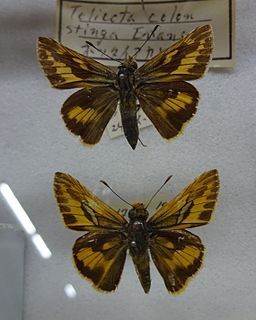Related Research Articles

Telicota colon, commonly known as the pale palm dart or common palm dart, is a butterfly belonging to the family Hesperiidae found in India to Australia.

Caprona ransonnetii, commonly known as the golden angle, is a butterfly belonging to the family Hesperiidae. It was first described by Baron Cajetan von Felder in 1868.

Bindahara phocides, the plane, is a small butterfly found Indomalayan and Australasian realms that belongs to the lycaenids or blues family.

Virachola perse, the large guava blue, is a species of lycaenid or blue butterfly found in the Indomalayan realm. It was described by William Chapman Hewitson in 1863. The larva feeds on Randia dumetorum.

Bibasis oedipodea, the branded orange awlet, is a species of hesperid butterfly found in South Asia and Southeast Asia. The butterfly was reassigned to the genus Burara by Vane-Wright and de Jong (2003) and is considered by them to be Burara oedipodea.
Spilosoma roseata is a moth of the family Erebidae. It was described by Walter Rothschild in 1910. It is found on Java in Indonesia.
Micraloa emittens is a moth of the family Erebidae. It was described by Francis Walker in 1855. It is found in India and Sri Lanka.
Micraloa lineola is a moth of the family Erebidae. It was described by Johan Christian Fabricius in 1793. It is found in India, Nepal, Sri Lanka and Myanmar.
Syllepte melanomma is a moth in the family Crambidae. It was described by George Hampson in 1912. It is found in Nigeria.
Timocratica leucocapna is a moth of the family Depressariidae. It is found in Colombia, Costa Rica, Peru and Venezuela.
Lecithocera luteola is a moth in the family Lecithoceridae. It was described by Alexey Diakonoff in 1968. It is found on Luzon in the Philippines.
Eupragia solida is a moth in the family Depressariidae. It was described by Walsingham in 1911. It is found in Mexico, where it has been recorded from Tabasco.
Timocratica agramma is a moth in the family Depressariidae. It was described by Vitor O. Becker in 1982. It is found in Espírito Santo, Brazil.
Timocratica longicilia is a moth in the family Depressariidae. It was described by Vitor O. Becker in 1982. It is found in Colombia. The habitat consists of tropical montane and tropical lower montane wet forests.
Timocratica meridionalis is a moth in the family Depressariidae. It was described by Vitor O. Becker in 1982. It is found in Brazil, Bolivia and Paraguay.
Timocratica xanthotarsa is a moth in the family Depressariidae. It was described by Vitor O. Becker in 1982. It is found in Panama.
Timocratica titanoleuca is a moth in the family Depressariidae. It was described by Vitor O. Becker in 1982. It is found in Peru.
Timocratica melanostriga is a moth in the family Depressariidae. It was described by Vitor O. Becker in 1982. It is found in Santa Catarina, Brazil.
Timocratica guarani is a moth in the family Depressariidae. It was described by Vitor O. Becker in 1982. It is found in northern Argentina and Paraguay.
Podalia lanocrispa is a moth of the family Megalopygidae. It was described by E. Dukinfield Jones in 1912. It is found in Brazil.
References
- ↑ Savela, Markku. "Timocratica Meyrick, 1912". Lepidoptera and Some Other Life Forms. Retrieved January 10, 2018.
- ↑ Bulletin of the British Museum (Natural History) (Entomology) 45 (3): 250
| This article on a moth of the family Depressariidae is a stub. You can help Wikipedia by expanding it. |